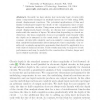Free Online Productivity Tools
i2Speak
i2Symbol
i2OCR
iTex2Img
iWeb2Print
iWeb2Shot
i2Type
iPdf2Split
iPdf2Merge
i2Bopomofo
i2Arabic
i2Style
i2Image
i2PDF
iLatex2Rtf
Sci2ools
DNA
2009
Springer
2009
Springer
Time-Complexity of Multilayered DNA Strand Displacement Circuits
Recently we have shown how molecular logic circuits with many components arranged in multiple layers can be built using DNA strand displacement reactions. The potential applications of this and similar technologies inspire the study of the computation time of multilayered molecular circuits. Using mass action kinetics to model DNA strand displacement-based circuits, we discuss how computation time scales with the number of layers. We show that depending on circuit architecture, the time-complexity does not necessarily scale linearly with the depth as is assumed in the usual study of circuit complexity. We compare circuits with catalytic and non-catalytic components, showing that catalysis fundamentally alters asymptotic time-complexity. Our results rely on simple asymptotic arguments that should be applicable to a wide class of chemical circuits. These results may help to improve circuit performance and may be useful for the construction of faster, larger and more reliable molecular ci...
Chemical Circuits | Computation Time | Computational Biology | DNA 2009 | Multilayered Molecular Circuits |
| Added | 26 May 2010 |
| Updated | 26 May 2010 |
| Type | Conference |
| Year | 2009 |
| Where | DNA |
| Authors | Georg Seelig, David Soloveichik |
Comments (0)

